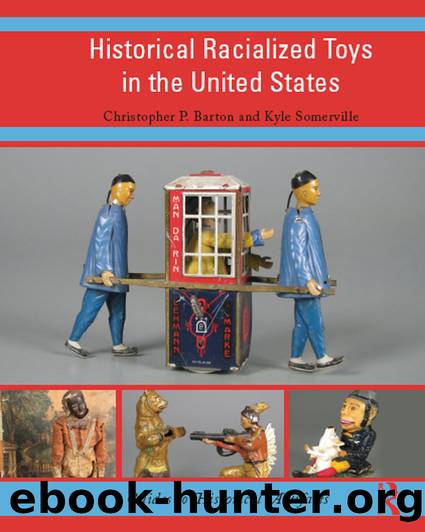Historical Racialized Toys in the United States by Christopher P. Barton Kyle Somerville

Author:Christopher P. Barton, Kyle Somerville [Christopher P. Barton, Kyle Somerville]
Language: eng
Format: epub
Tags: Social Science, Archaeology
ISBN: 9781315528878
Google: 9Tn7CwAAQBAJ
Publisher: Routledge
Published: 2016-04-14T06:02:12+00:00
Target Games and Cap Pistols
Dubin (1987:133) suggests that, in addition to the humorous nature of these toys, there is also the suggestion of violence toward other races, a suggestion that is sometimes implicit but was also often shockingly explicit. These are perhaps best represented by target games and cap pistols, all of which appear to have been manufactured between 1879 and 1893. These examples are particularly interesting because of the overt depiction of violence toward non-White peoples. The âChinese Must Goâ cap pistol depicts a white Nativist man grasping a Chinese manâs queue. When the trigger is pulled, the White kicks the Chinese man in the behind, detonating the cap placed in the Chinese manâs mouth. Similarly, the Cap Head exploder functioned by placing a cap in the caricatured head of a Chinese man, and the head was struck with the hand, setting off the cap. Like the âChinese Must Goâ cap pistol, the âNiggerheadâ and âSamboâ cap pistols used violence toward Blacks as the means of setting off the caps. A Black figure formed the handle of the pistol, and the cap was inserted into the figureâs mouth. Engaging the pistolâs hammer struck the cap and ignited it. In the case of target games, however, the suggestion of violence is more implicit, and only becomes apparent by playing the game (Dubin 1987:133). For example, the instructions for the 1890 McLoughlin Brothersâ (the company was later acquired by Milton Bradley in 1920) âJolly Darkie Target Game,â read:
The game is to throw the balls in to the Darkieâs mouth. Each player in turn throws all the balls, and score one for each that goes in the mouth. If a ball comes out again through one of the holes, it scores as many extra balls for the player as the number marked near the hole indicates. A certain number of points is set as the limit of the game, and the player who first scores that number wins. (McLoughlin Brothers 1890)
Unlike the more obvious expressions of violence provided by exploding caps using the body parts of non-White figures, target games depict a symbolic form of violence that is largely masked by the entertainment function of playing the game, where tossing a ball or bean ball at a caricatured Black individual to score points reinforces both the service role of the Black figure and the complicity of the Black figure in his own servitude (his, as these childrenâs games exclusively depict male figures) (Dubin 1987:133).
Download
This site does not store any files on its server. We only index and link to content provided by other sites. Please contact the content providers to delete copyright contents if any and email us, we'll remove relevant links or contents immediately.
Cecilia; Or, Memoirs of an Heiress — Volume 1 by Fanny Burney(31437)
Cecilia; Or, Memoirs of an Heiress — Volume 3 by Fanny Burney(31030)
Cecilia; Or, Memoirs of an Heiress — Volume 2 by Fanny Burney(30978)
The Great Music City by Andrea Baker(22608)
We're Going to Need More Wine by Gabrielle Union(18119)
Bombshells: Glamour Girls of a Lifetime by Sullivan Steve(13152)
Pimp by Iceberg Slim(12984)
All the Missing Girls by Megan Miranda(12825)
Fifty Shades Freed by E L James(12487)
Talking to Strangers by Malcolm Gladwell(11969)
Norse Mythology by Gaiman Neil(11952)
Crazy Rich Asians by Kevin Kwan(8404)
Mindhunter: Inside the FBI's Elite Serial Crime Unit by John E. Douglas & Mark Olshaker(7885)
The Lost Art of Listening by Michael P. Nichols(6523)
Enlightenment Now: The Case for Reason, Science, Humanism, and Progress by Steven Pinker(6442)
Bad Blood by John Carreyrou(5810)
The Four Agreements by Don Miguel Ruiz(5568)
Weapons of Math Destruction by Cathy O'Neil(5091)
We Need to Talk by Celeste Headlee(4915)
